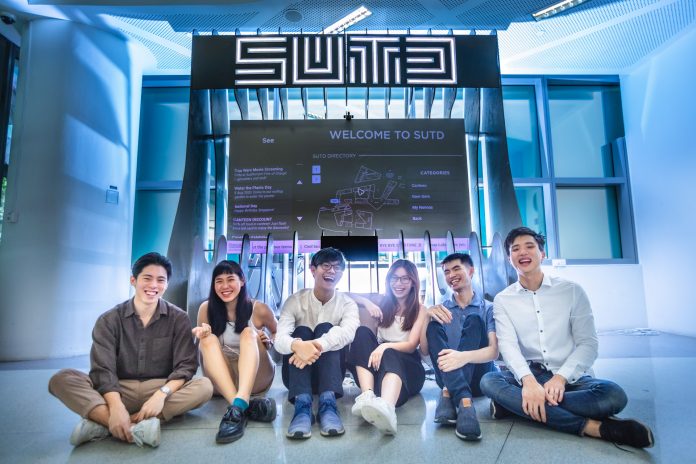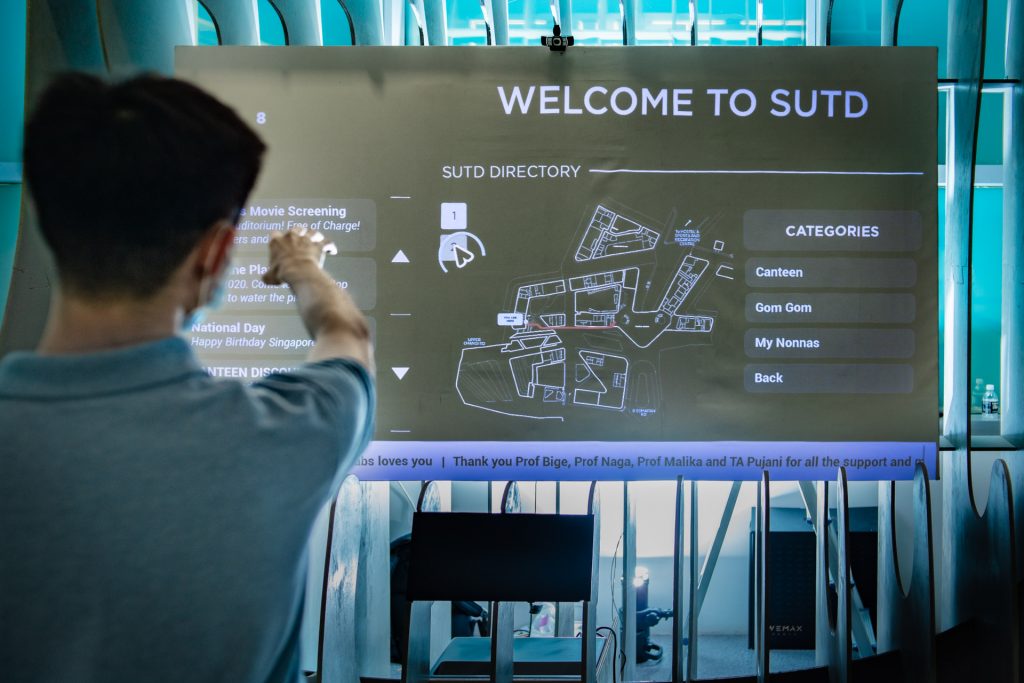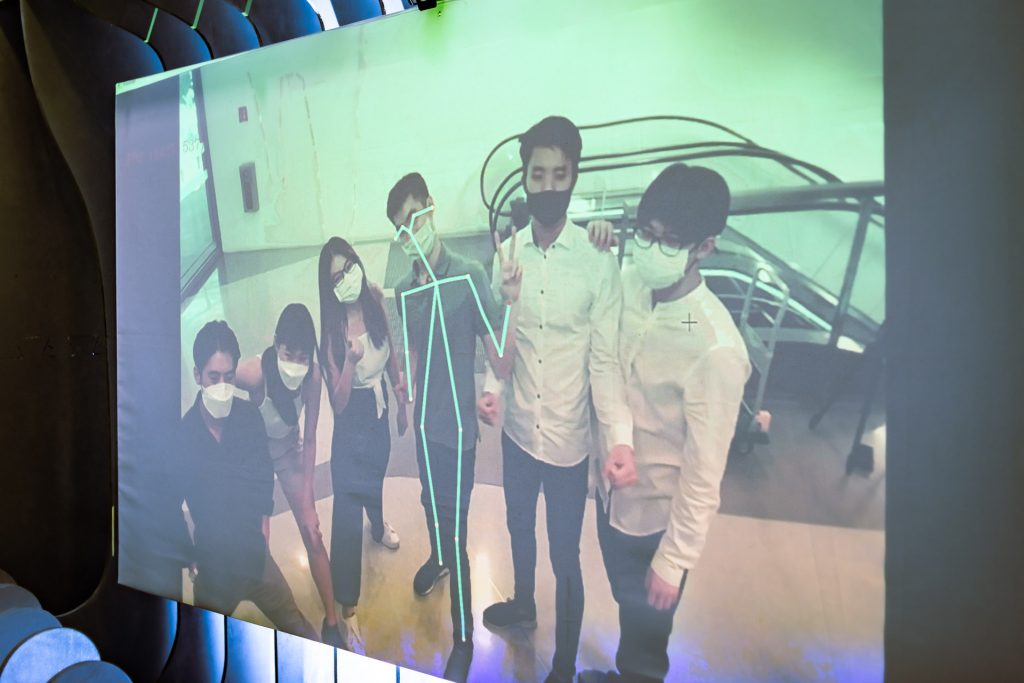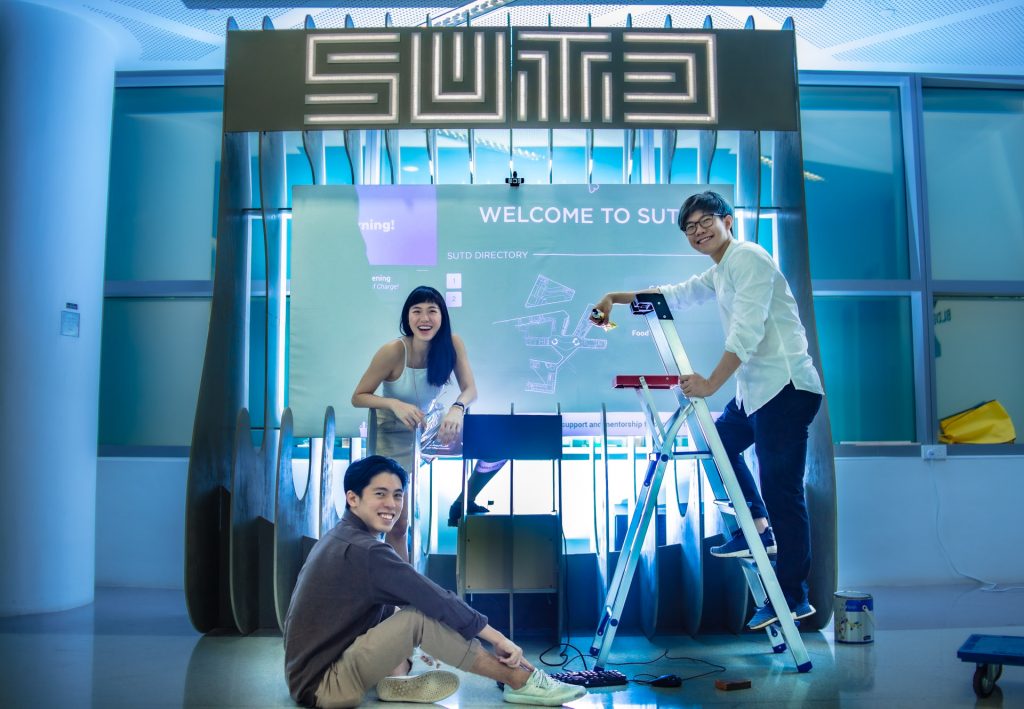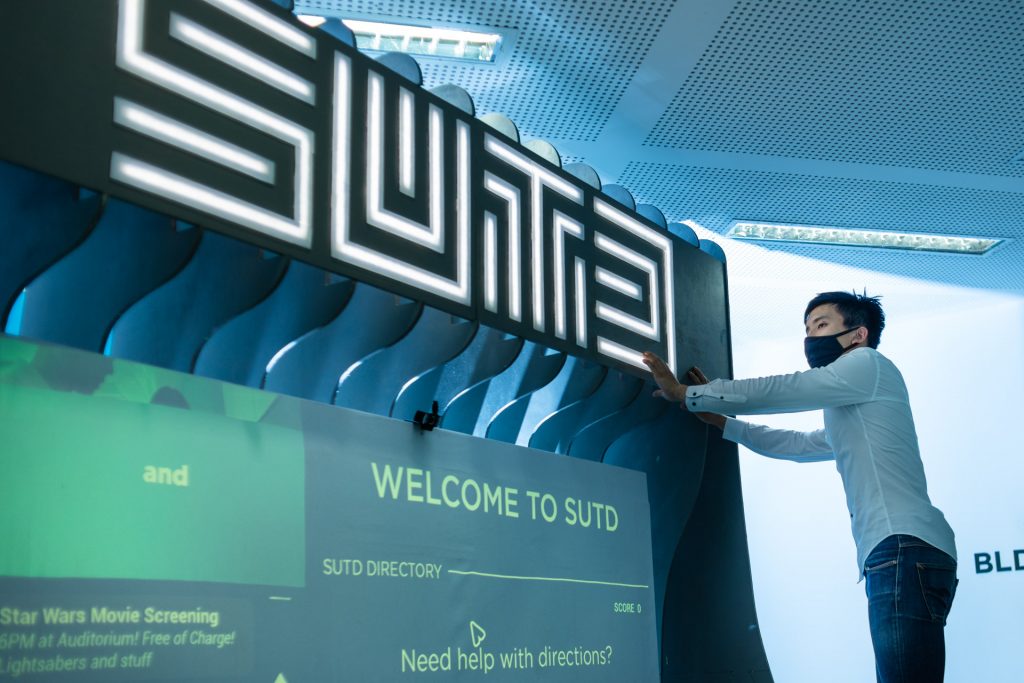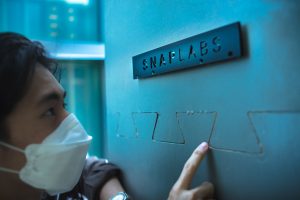Getting around our campus grounds just got a lot more fun!
Contactless Wayfinding Installation by Snap Labs
Team members (from left to right): Sean Lee Jun Wei (ASD), Lee Qian Yi Jeanette (ASD), Lee Kai Min Frank (EPD), Cheryl Low Rui Min (EPD), Tang Mingzheng Paul (ISTD), Yong Khai Sheen (ISTD)
Due to their schedules, the interview was conducted with Cheryl, Sean, and Jeanette.
Welcome to SUTD!
If you’re a first-time visitor stepping foot into our campus, it’s reasonable to feel a little lost. While you can always call out to a passing student to ask for directions, we’re pleased to say we now have a dedicated platform in place to guide you in the right direction, made by our students no less! Located at the MRT entrance that opens straight into SUTD, you’ll notice it right away and realise that it isn’t your usual touchscreen directory.
Inventing the intuitive interface
“We deliberately built a barrier between the user and the projector screen, so as to tell the user that it’s not a touchscreen,” Sean explains. “But the moment the user raises his/her hand, the cursor tracks and mirrors the gesture. The idea is to make the user interface as intuitive as possible so that we can do away with the instruction guide. But to accomplish this, we had to really think about how people would instinctively interact with the directory.”
“Figuring out which controls were intuitive and which weren’t challenged our perceptions of user experience,” Cheryl adds on. “We explored many different methods of navigating the directory. For example, to click, we could mime a hand grab or push our hand forward. So we tested all these approaches on people, and if they couldn’t figure out the controls, we would try another way. Eventually, we settled on hovering over a point to click.”
Same same but different
The team originally came together with the idea to work on a virtual reality (VR) Capstone project, but the barrier to adopt this technology was (and is still) relatively high. So the team members had to think about how VR could be practically integrated into the current day and age.
The sensors are designed to detect the person standing nearest to the wayfinder.
“This led us to explore experiential marketing,” Jeanette elaborates. “We saw cool videos of VR marketing experiences and we thought it was a really interesting idea. We also didn’t have a proper directory in SUTD. It’s not a big problem, but it’s still a problem, especially for visitors. So we combined these two inspirations together. It’s a directory, but it’s not like the regular ones you see in shopping malls or even at the airport. And with the whole Covid-19 situation, the contactless feature just made even more sense.”
A team effort on all levels
With that in mind, the team went to approach SUTD’s marketing department to explore the possibility of doing a Capstone project with the university.
“It was quite a back and forth process,” Cheryl recounts. “You can say that the final product is a combination of what all the stakeholders, including ourselves, wanted. But the central concept of the project (the contactless wayfinding) did not change throughout the whole journey.”
The Capstone team wanted the project to incorporate new technologies. The Office of Marketing and Communications requested to have a list of upcoming and current events in the directory, and to include a content management system (CMS). The Office of Campus Infrastructure and Facilities was also roped in to advise the Capstone team on the most suitable location to house the wayfinder.
“Our project is very unique because you have students, professors, and staff members coming together to see this to fruition,” Sean says proudly. “Also, most Capstone projects require students to create a proof of concept, but in our case, we took it one step further because we were building the actual product from the get-go.”
Sharing (skills) is helping
Behind every Capstone project lies a unique blend of students trained in different disciplines, and this project is no exception. While the ISTD team members worked on the directory and CMS system, the ASD and EPD students had their hands full designing and putting the physical structure together, LED lighting, wiring and all. Jeanette tells us more about the team dynamics:
“Interestingly, the transferring of skills and knowledge was most critical for our team. We had a time crunch on our project, so learning from each other allowed us to help out in areas where it mattered most, while allowing us to complete the project within the time frame.”
Cheryl chips in: “For example, Jeanette and I would be helping out with the software – at one point, we were even creating the user interface directly within the Unreal Engine. You would also see our ISTD team members coming down to the Fabrication Lab to sand and process the wood (for the physical structure).”
The dinosaur inspiration
It was this close level of cross-collaboration between the team members that gave the project a fun spin. As everyone was involved in creating the user interface (as opposed to just the ISTD team members), Cheryl and Jeanette added an unplanned but otherwise well-received surprise into the project. We ask them to elaborate.
“Jeanette and I like adding little, cute ideas into our projects,” Cheryl explains. “So we wanted to incorporate an element of fun in the directory. We were inspired by the dinosaur game that pops up on your Google web browser whenever there’s no Internet connection, so we decided to create an SUTD version of the mini game.”
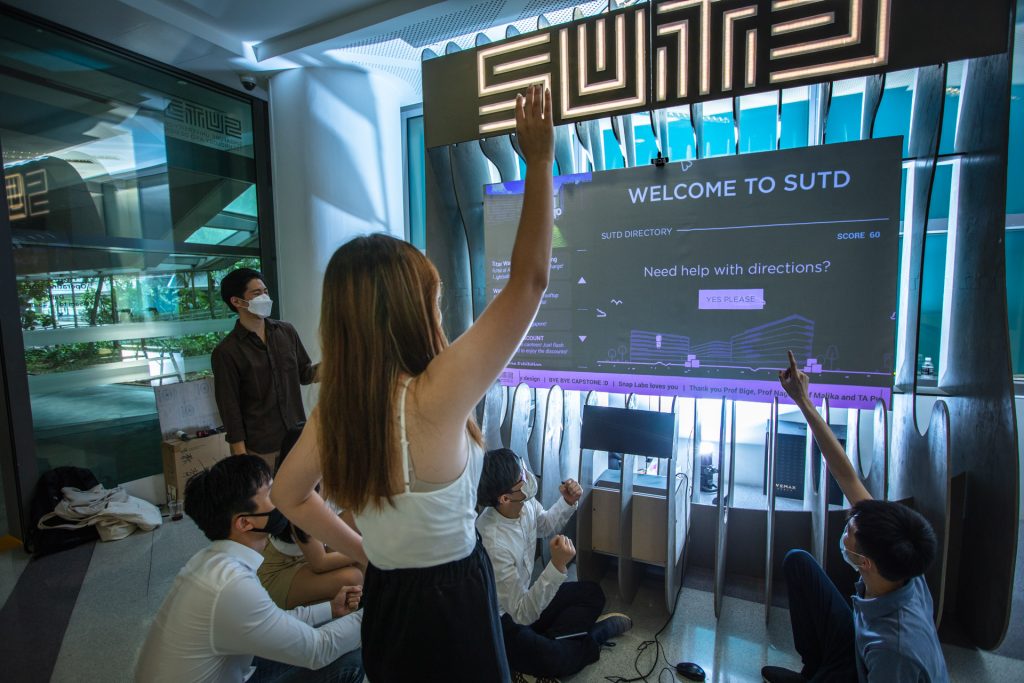 Raise your hand to make the robot jump over obstacles in the mini game!
Raise your hand to make the robot jump over obstacles in the mini game!
“SUTD didn’t have a mascot, so I went through this thought process when I was designing the game character,” Jeanette recalls. “I eventually settled on the idea of using a robot to represent SUTD. We also used iconic landmarks in our campus to replace the cacti in the original game.”
Incredibly, this seed of inspiration would grow from a small Easter egg to eventually influencing the structure’s design, which is shaped like an arcade game console!
“In fact, the game was one of the features that our Capstone professors were most excited about. Even though it’s a small part, it changes the whole user experience of the wayfinder,” Cheryl laughs.
It’s never easy running a startup
Speaking about experience, the team shares with us what it was like doing an entrepreneurship Capstone project.
“Right off the bat, you have a more personal stake in this,” Sean says. “You get funding when you do a Capstone project with an industry partner. But for entrepreneurship projects, for every $7 SUTD puts in, we put in $3. So just from the funding alone you can feel the difference.”
Besides the money, the team also has to be very practical about what their project aims to achieve. Jeanette shares: “When we first started, we had a lot of ideas that we thought we could explore through the Capstone project. But when we spoke to our mentors and stakeholders, they were asking questions like “what business problems are you solving”, and it forced us to be very critical of our project’s objective.”
The pandemic also presented an unprecedented challenge to the team. All entrepreneurship Capstone teams originally get to undergo an entrepreneurship launch pad programme, but this ground to a standstill when the social distancing and safety measures were implemented. The team had to overcome the challenges of getting market validation, speaking to external industry experts, and networking without face-to-face meetups.
But it’s not all gloom and doom, Sean assures us. “The nature of SUTD’s curriculum is that we’ve always been very involved in projects since the first year. And this design-centric education also empowers us.”
Cheryl chimes in: “Besides the education, SUTD also gives us a lot of opportunities. Except for Sean and Khai Sheen, the rest of us are actually running a startup together. Thanks to these opportunities, we went for many hackathons and met interesting people who taught us the ropes of running a business. This helped us to better plan our work processes despite the hiccups.”
So, what’s next for this project?
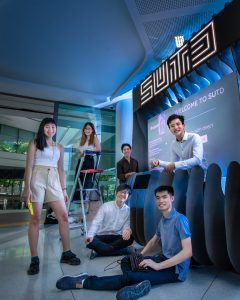 The team wants to add some improvements to the wayfinder before officially handing it over to the marketing department, but otherwise most of the work is already complete. Cheryl reflects on the team’s objective for the project.
The team wants to add some improvements to the wayfinder before officially handing it over to the marketing department, but otherwise most of the work is already complete. Cheryl reflects on the team’s objective for the project.
“It started with the idea of livening up the MRT tunnel space,” she explains. “We want the wayfinder to be an iconic landmark that people would notice when they enter the campus (via the MRT).”
Like what you just read?
Check out the Contactless Wayfinding Installation page on our Capstone Design Showcase 2020 website for more videos and information!
https://capstone2020.sutd.edu.sg/projects/contactless-wayfinding-installation-by-snap-labs-discover
Missed our Open House talks? Rewatch the sessions here.
#whySUTD? We’re glad you asked – here’s why!
It can be hard to ask the right questions that will help you to decide which university to join, so we’ve compiled a list of FAQs for you here.




















